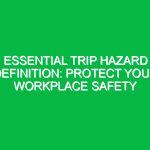Introduction
Toolbox talks for construction are short, informal Safety meetings that focus on specific health, safety, and environmental (HSE) issues relevant to the construction industry. These discussions are essential for fostering a culture of Safety on construction sites, ensuring that workers are aware of potential Hazards, proper Procedures, and the importance of compliance with safety Regulations. In an industry where risks are abundant, effective Toolbox Talks can significantly reduce accidents and improve overall site safety.
In this article, we will explore the importance of toolbox talks for construction, discuss key components and Best Practices, and highlight how these discussions can enhance HSE compliance. With the right approach, toolbox talks can not only fulfill regulatory requirements but also empower workers to take ownership of their safety.
Understanding Toolbox Talks
Toolbox talks for construction are typically brief sessions that occur regularly, often at the beginning of a shift or before starting a particular task. They serve multiple purposes:
- Educate workers about specific safety Hazards associated with their tasks.
- Reinforce the importance of safety protocols and regulations.
- Encourage open communication about safety concerns among team members.
These discussions are not merely checkboxes to tick off; they are vital components of an effective safety management system. When conducted properly, toolbox talks can initiate meaningful conversations about safety and foster a culture where everyone feels responsible for maintaining a safe work Environment.
The Components of Effective Toolbox Talks
To ensure toolbox talks for construction are effective and engaging, it is important to include several key components:
1. Relevant Topics
Selecting topics that are pertinent to the work being performed is crucial. This may include:
- Hazard recognition and risk assessment
- Personal protective equipment (PPE) requirements
- Safe use of tools and machinery
- Emergency response procedures
- Environmental considerations, such as waste management and pollution Prevention
For instance, if a crew is about to start work on scaffolding, a Toolbox Talk could focus on the specific hazards associated with working at heights, the importance of Fall Protection, and the proper inspection of scaffolding equipment.
2. Engaging Delivery
The delivery of toolbox talks should be interactive and engaging. Presenters can use various techniques to involve participants, such as:
- Asking questions to encourage discussion
- Using real-life scenarios or case studies to illustrate points
- Incorporating multimedia presentations or visual aids
An example could involve a project manager sharing a personal story about a near-miss incident that occurred due to a lack of communication regarding safety protocols. This can resonate with workers and encourage them to remain vigilant.
3. Documentation
Keeping records of toolbox talks is essential for compliance and continuous improvement. Documentation should include:
- Date and location of the talk
- Topics discussed
- Attendees’ names and signatures
- Any feedback or concerns raised during the talk
Having a documented history of toolbox talks can help organizations track safety trends, demonstrate compliance during audits, and identify areas for improvement.
4. Follow-Up and Feedback
After conducting a Toolbox Talk, it is important to follow up on any issues or concerns that were raised. This could involve:
- Addressing any safety concerns highlighted by workers
- Implementing changes based on feedback received
- Conducting follow-up discussions to reinforce key points
For example, if workers express concerns about the adequacy of PPE, the management can take action to procure better equipment or provide additional Training on correct usage.
Benefits of Toolbox Talks
Implementing toolbox talks for construction offers numerous Benefits, including:
1. Enhanced Safety Awareness
Regular toolbox talks keep safety at the forefront of workers’ minds. By consistently discussing relevant topics, workers are more likely to remain vigilant and proactive in identifying potential hazards.
2. Improved Communication
Toolbox talks create a platform for open dialogue about safety concerns. Workers are encouraged to voice their opinions and share their experiences, leading to a more cohesive team environment.
3. Increased Compliance with HSE Regulations
Regularly scheduled toolbox talks help organizations meet legal requirements for safety training and communication. This not only mitigates the risk of fines but also enhances the organization’s reputation within the industry.
4. Reduction in Accidents and Incidents
By fostering a culture of safety and ensuring that workers are well-informed about potential hazards, toolbox talks can lead to a significant reduction in workplace accidents and incidents. This is not just beneficial for workers but also reduces costs associated with injuries and project delays.
Real-Life Examples and Case Studies
To illustrate the impact of effective toolbox talks, let’s examine a couple of hypothetical scenarios:
Scenario 1: High-Rise Construction
On a high-rise construction project, workers had previously experienced a series of near-misses involving falling tools. The project manager initiated a Toolbox Talk focusing on fall protection measures and the importance of securing tools at heights.
During the discussion, workers shared their experiences and suggestions for improvement. Following the talk, the team implemented a new policy requiring all tools to be secured with lanyards. Over the following weeks, the site reported no incidents related to falling tools, demonstrating the effectiveness of the Toolbox Talk.
Scenario 2: Hazardous Materials
In another instance, a construction site was preparing to handle hazardous materials for the first time. The site supervisor conducted a Toolbox Talk on the proper handling, storage, and disposal of these materials.
Workers voiced concerns about potential exposure and shared tips from previous experiences. The supervisor took this feedback seriously and arranged for additional training and PPE. As a result, the crew felt more prepared and confident, ultimately reducing the risk of exposure incidents.
Regulations and Standards Impacting Toolbox Talks
Toolbox talks for construction are influenced by various regulations and standards, which may vary by location. In many regions, regulations require employers to provide adequate training and communication regarding health and safety hazards.
For instance, in the United States, the Occupational Safety and Health Administration (OSHA) regulations mandate that employers maintain a safe work environment and provide necessary training for employees. Regular toolbox talks can help organizations comply with these standards by ensuring that workers are informed about safety protocols and hazards.
Additionally, industry standards such as ISO 45001 emphasize the importance of engaging workers in safety discussions. Following these regulations not only protects workers but also enhances the organization’s credibility and compliance standing.
Best Practices for Conducting Toolbox Talks
To maximize the effectiveness of toolbox talks for construction, organizations should adopt Best Practices that include:
- Scheduling talks regularly to maintain consistent safety communication.
- Prioritizing relevant, site-specific topics based on current tasks and conditions.
- Encouraging participation and feedback from all team members.
- Utilizing experienced personnel to lead discussions and share insights.
A commitment to these best practices will ensure that toolbox talks become a valuable part of the safety culture rather than a mundane routine.
Conclusion
In conclusion, toolbox talks for construction play a vital role in promoting health, safety, and environmental compliance on job sites. By educating workers, fostering open communication, and adhering to regulatory requirements, organizations can create a safer work environment while reducing the risks of accidents and injuries.
The importance of these discussions cannot be understated; they are not merely a box to check but an opportunity to engage with workers and prioritize their safety. As the construction industry continues to evolve, embracing effective toolbox talks will be essential in cultivating a proactive safety culture that benefits everyone involved.
By prioritizing toolbox talks, construction companies can boost their HSE compliance today and pave the way for a safer, more responsible industry.


